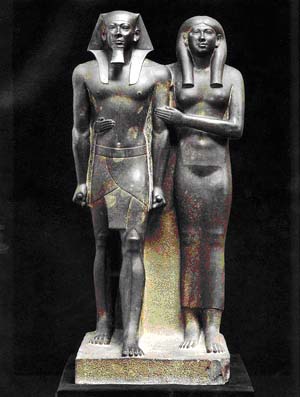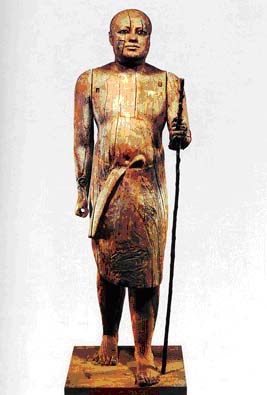|

|
King Menkaure and His Queen, Museum of Fine Arts, Boston
|
This is the standing pair statue of King Menkaure and his queen (circa 2490-2472 B.C.), possibly Khamerernebty II of the 4th Dynasty in the Old Kingdom period. The two figures stand shoulder by shoulder. Youthful vigor characterizes the figure of the king as he strides forward, protectively embraced by the queen. His head is turned slightly to the right, while the queen's face is fully frontal, as if she were presenting him to the world and endowing him with confidence and strength.
Their left feet are slightly advanced; however the upper body does not respond to this uneven distribution of weight - there is no tilt in the shoulders, nor a shift in the hips. It is the first try of the Egyptian statuary to put all the weight of the figure on one leg while the other leg is slightly lifted. This standing pose stresses the stability and soundness in the figure portrayed.
For the first time in Egyptian art, both royal heads are not images of idealized royalty but portraits of specific holders of the offices. The king's bulbous eyes, hanging flesh on the cheeks, and drooping lower lip are unmistakably features of an individual, as are the queen's long full neck and small mouth.
The king's muscular arms hang down his athletic body; his fists are clenched, signifying the centralization of power. Menkaure is wearing a royal headpiece and a short royal kilt. The queen is wearing a ceremonial wig common among the females and a thin garment that reveals more of her body than it actually conceals, clearly distinguishing the protruding breasts and pubic triangle. The senses of calm and confidence of these two figures were achieved through the compactness and the solidity of the composition. Everything about the statues, the scale, their solid appearance, the hard stone from which they were carved, conveys a feeling of royal dignity.
The group was not finished, since the lower part has not been fully smoothed. Paint was applied, as seen in the traces of red on the king's ears, and sheet gold may once have covered the woman's wig and the king's headdress. The coverings would have incorporated a cobra above the king's forehead and, possibly, a vulture headdress above the queen's wig.
|

|
Wooden Statue of Ka-Aper
|
In ancient Egypt, the Pharaohs and aristocrats were usually portrayed strictly according to the law of frontality, which rigidified but at the same time dignified the objects. The statues of people of lower hierarchies, on the contrary, were hardly restricted by such formulas, and tended to be more vivid and realistic. Mostly, this kind of statue was for funerary use, typified by the wooden statue of Ka-Aper, which is also called "Headman of the Village."
KA-APER is a Fourth Dynasty woodcarving 110 centimeters in height. As the manager of the royal manor of his time, Ka-Aper supervised the slaves at the farm and organized them to build dams and irrigation canals. It is said that when the statue was excavated in Mariette, a worker exclaimed on seeing it, "Isn't it the headman of our village?" Actually, being quite stout and vigorous, Ka-Aper is very likely to be associated with a typical country official.
